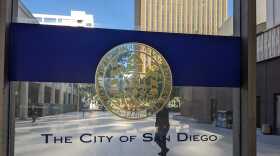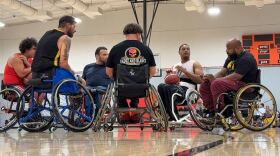Carlos Sanchez of McAllen, Texas, took out an enormous amount of federal student loan debt to make sure his children could attend college.
"As my third child makes her way through her senior year in college, I now have what amounts to about $160,000 in parent PLUS loans," Sanchez, 63, told NPR. He likely won't have them paid off (or qualify for debt forgiveness) until he's in his 80s, "which is an extraordinary journey for me," he said, given that he's approaching retirement.
"I'm just hoping to see if there is some relief."
For Sanchez and millions of other parents and caregivers, that relief could come through a loophole in federal law — a loophole that could help them access a more forgiving payment plan and ultimately shed debts that might otherwise follow them for the rest of their lives.
That is, if they know about it. Few do.
The U.S. Department of Education won't discuss this loophole. And if a borrower calls their loan servicer and asks about it, the call center worker will likely greet the question with a confused silence. It's called the double-consolidation loophole.
The parent PLUS debt trap
According to federal data, 3.7 million Americans hold $111 billion in debt from parent PLUS loans. Though they're federal loans, if you close one eye and squint at them sideways, parent PLUS loans look an awful lot like a bear trap. The interest rate is far higher than the rate on a standard undergraduate loan — 8.05% versus 5.50% — and parents don't have easy access to the low monthly payments of income-based repayment plans. There's also virtually no limit on how much families can borrow. Which can be good. Or calamitous.
In the ideal, parent PLUS loans can be engines of equity, helping low-income families and families of color send their children to schools that, because of cost and generational wealth gaps, might otherwise be out of reach. But research suggests that these loans often become the opposite: drivers of inequity.
"Because low-income families, and especially Black and Latino/a parents, are disproportionately taking out Parent PLUS loans, their heavy use and unfavorable terms and conditions exacerbate the racial wealth gap," said a 2022 report from the Century Foundation titled "Parent PLUS Borrowers: The Hidden Casualties of the Student Debt Crisis."
At a recent forum on student loan debt, Rep. Ayanna Pressley, D-Mass., opined on this parent PLUS crisis, saying she'd "spoken to Black parents who say, 'I'm of age to retire, but I cannot retire — because I'm still paying on loans that I took out so my baby could have a better life.'"
"I'm really worried about parent PLUS borrowers," said Wisdom Cole, national director of the NAACP's Youth & College Division.
Making matters worse, Cole said: These parent borrowers have been unfairly excluded from the newest, most flexible repayment plan, SAVE. Cole said the NAACP had expressed its concern over this exclusion to both the Biden administration and the Education Department.
In fact, in a letter sent Tuesday, NAACP President and CEO Derrick Johnson warned Education Secretary Miguel Cardona that "Parent PLUS borrowers face a grim reality as loan repayments restart."
Parent PLUS borrowers can't officially access the most forgiving payment plan
Parents' official exclusion from SAVE is a big deal. (Unofficially, this is where the loophole comes in — more on that below.)
Technically, parent PLUS loan borrowers qualify for only the Standard, Graduated and Extended repayment plans, none of which take a borrower's income into account or promise loan forgiveness after a given period of time.
Parent PLUS borrowers can qualify for the least flexible income-based repayment plan, known as Income-Contingent Repayment (ICR), if they consolidate their loans into a Direct Consolidation loan. But monthly payments on ICR can be high compared with those on the SAVE plan.
ICR calculates payments based on 20% of a borrower's discretionary income, while SAVE uses half that: just 10%. Also, ICR defines discretionary income as any money you earn above 100% of the federal poverty level. Translation: Any income an individual borrower earns over $14,580 is factored into the monthly payment math. The SAVE plan, on the other hand, protects more than twice as much of a borrower's income, allowing anyone who earns less than roughly $33,000 to qualify for a $0 monthly payment.
In short, if there were a way for parent PLUS borrowers to access SAVE, their monthly payments would be vastly lower than they are on ICR.
That's why, in Johnson's letter, the NAACP president urges Cardona to use his authority to expand SAVE access to parent PLUS borrowers. Otherwise, he writes, "millions of families will see the resumption of crippling payments as student loan payments resume this month."
It's unclear whether the Education Department believes it can — or will try to — do as Johnson asks. In the meantime, though, there is a way for parents to access SAVE, through an unofficial backdoor.
How the double-consolidation loophole works
The federal student loan system — as well as this loophole — depend on layers, like the floors of a home. Consolidating a parent PLUS loan, for example, is like laying a rug over a hardwood floor. The Education Department and its loan servicers can see the rug — the newly consolidated loan — but they can also still see the hardwood — a parent PLUS loan — beneath.
But when you consolidate a loan twice, it's like laying wall-to-wall carpet over it all: Servicers can no longer tell what's beneath. And the system can prevent parent PLUS loans from qualifying for the SAVE plan only if it knows they're parent PLUS loans.
The Education Department knows this is a problem.
"In the past, limitations in Department data may have enabled a parent PLUS loan that was consolidated and then re-consolidated to enroll in any [income-driven repayment] plan, despite the Department's position that such loans are only eligible for the ICR plan," the department acknowledged in the Federal Register in July. Still, it's not immediately closing the loophole.
So, how does a borrower fit through this narrow opening?
It is complicated, and, as we said earlier, the Education Department and its servicers won't help you with it. So if you choose to proceed, you're on your own. Sort of.
You'll find explainers here, from Student Loan Planner, and here, from the College Investor. Below, we've reprinted detailed instructions from Massachusetts' Office of the Attorney General, recommended for borrowers with at least two parent PLUS loans:
Rickey Calloway, a Florida-based artist who gained a reputation for his James Brown-like vocals, was working as a janitor in a school when he learned about his success on the other side of the pond. Calloway ended up relaunching his career in the UK and Europe. Others, like Charles Simmons, never saw their success during their lifetime. Step 1: Fill out a consolidation application online on studentaid.gov for just one Parent PLUS Loan. Pick Nelnet for the servicer. Download a copy of your application to help you with Step 2. It will contain account numbers, balance information, loan type codes, and servicer names needed for your next application. "He was a car mechanic and he died in a pauper's grave," says Lewis Henderson of DNSC. Step 2: Fill out a paper consolidation application for the second Parent PLUS Loan. Henderson credits the uplifting lyrics to Simmons' single "Save the World" for sending a message of coming together during difficult times. Generic drugs, in other words, are critically valuable to patients and yet are treated as having almost no value in the marketplace. Once drugs run out of their patents and can be manufactured and sold as generics, they are usually sold in bundles and unmarked, so pharmacists or patients cannot compare one drug's quality against that of another maker. As a result, the only difference that drugmakers compete on is price. -On page three of the paper application, identify the loans you want to exclude from the consolidation. Fill in information about the Parent PLUS Loan that you included in the application you completed on studentaid.gov. -Send the completed paper application to Aidvantage. Step 3: After you have received notice from both Nelnet and Aidvantage that your two new Direct Consolidation Loans have been funded, fill out a final paper consolidation application. "The facts are that the price just goes down, down, down, down, down," says David Gaugh, interim CEO of the Association for Accessible Medicines, which represents generic makers. "At some point in time as a company, I've got to make a decision: Can I continue to make this product or not?" The answer, for an increasing number of companies, is no. The race to rock-bottom generic prices has made it hard for manufacturers to stay in business, in turn creating various problems with drug quality and the lack of redundant supply to buffer the impact of disruptions. -You can send the application to the servicer of your choice, but if you're pursuing PSLF, send it to MOHELA. Step 4: After receiving notice that your final Direct Consolidation Loan is funded, visit studentaid.gov/idr, log in using your FSA ID and password, and fill out an Income-Driven Repayment plan application, choosing the SAVE plan.
We know. It sounds complicated and tedious. Because it is. And to be clear, NPR is not advising parent PLUS borrowers to do this; we're simply making clear it's an option. At least, it's an option until July 2025, when the Education Department says it will officially close the loophole.
Copyright 2025 NPR







